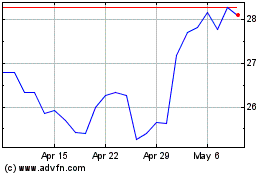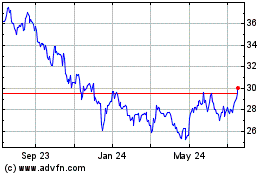mRNA Covid-19 Vaccines Are Fast to Make, but Hard to Scale
March 03 2021 - 8:29AM
Dow Jones News
By Jared S. Hopkins, Joel Eastwood and Dylan Moriarty
Pfizer Inc. and partner BioNTech SE did the unimaginable when
they developed a Covid-19 vaccine in less than a year. Previously,
the quickest vaccine development program was the four years it took
to make the mumps vaccine, licensed in 1967.
A big reason for the speedy success: a new gene-based technology
involving messenger RNA, the molecules that carry genetic
instructions. Yet that technology has also complicated
manufacturing, forcing companies to redo how shots get made.
Bottlenecks have emerged, manufacturing experts say, because
some steps are difficult to scale up quickly or because they simply
haven't been done before.
mRNA vaccines instruct cells to make a harmless version of the
spike protein that juts from the new coronavirus. Production of the
protein trains the immune system to recognize the real coronavirus
-- and fight it.
To make mRNA vaccines, Pfizer assembled a bespoke manufacturing
network that the company projects will make 2 billion doses this
year.
Here's how the vaccine is made and why manufacture is so hard to
scale up:
Step 1: Duplicate DNA
In a plant near St. Louis, Pfizer scientists synthesize DNA, the
key to creating this kind of vaccine. This step in the process
isn't new to the drug industry, but Pfizer needed to scale it up
fast.
The resulting solution is portioned out into clear 1-gallon
bottles, which are then frozen, packed into special plastic bags
and shipped to Andover, Mass.
Step 2: Convert DNA to mRNA
Next, the manufacturer turns the DNA into messenger RNA. The
mRNA carries the instructions that tell cells to make proteins
mobilizing immune defenses against the new coronavirus. At its
plant in Andover, Pfizer is performing this step at a much larger
scale than research labs have done before to meet the heavy demand
for Covid-19 vaccines.
The mRNA is packed into plastic bags the size of a large
shopping bag, each containing 5 million to 10 million doses. It
undergoes quality checks and is frozen for shipment to
Michigan.
Step 3: Add fat
The biggest bottleneck in producing mRNA vaccines, manufacturing
experts say, is the formulation process: Putting the synthesized
mRNA in a fatty envelope to reach its cellular destinations.
Few companies make lipids, the tiny fat particles that wrap
around the mRNA and safeguard it during its journey through the
body. Pfizer contracted with suppliers to receive lipids and has
begun making them in-house.
At a Pfizer plant in Michigan, a formulation suite designed by
the drugmaker -- the size of a one-car garage -- is crisscrossed by
pumps and pipes, and crowded with tanks, filtration units and
half-dollar size jet mixers. This is where the mRNA is encapsulated
in the lipids.
The Michigan plant uses about 100 mixers for the formulation,
which happens continuously over 30 hours to make about 3 million
doses.
Step 4: Test and package
This final step packages the mRNA vaccine for shipment, in a
process known as fill-finish.
Pfizer does the work at the same plant in Michigan, filling
hundreds of vials a minute, with six doses in each tiny container.
The company caps, labels and packs the vials into containers the
size of pizza boxes. It takes about two days to complete a batch of
more than a million doses.
Then the batches must undergo inspections and two weeks of
sterility testing to make sure they aren't contaminated, meet
additional quality specifications and won't leak.
The vials that clear inspection and testing are stored in
subzero freezers and await shipment to trucks or airplanes for
distribution.
Pfizer last month said it would help boost production in the
U.S. by incorporating more plants and bringing on two contract
manufacturers.
Johnson & Johnson's newly authorized vaccine also uses a new
gene-based technology, but not mRNA. To boost production, Merck
& Co. will help make the vaccine.
Graphics sources: Pfizer; Matthew Johnson, Duke University;
Jennifer Pancorbo, North Carolina State University.
Write to Jared S. Hopkins at jared.hopkins@wsj.com
(END) Dow Jones Newswires
March 03, 2021 08:14 ET (13:14 GMT)
Copyright (c) 2021 Dow Jones & Company, Inc.
Pfizer (NYSE:PFE)
Historical Stock Chart
From Mar 2024 to Apr 2024

Pfizer (NYSE:PFE)
Historical Stock Chart
From Apr 2023 to Apr 2024
